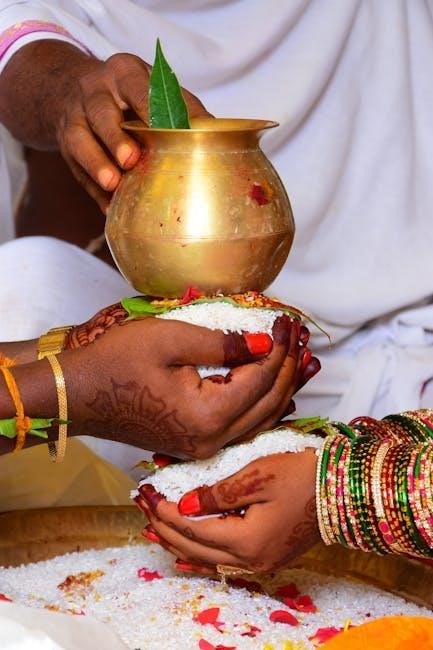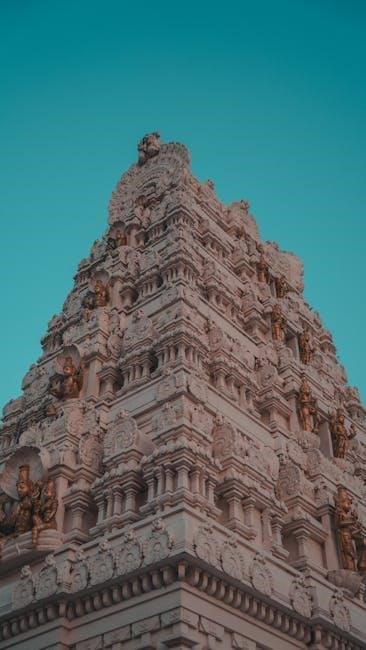Venkateswara Ashtothram is a devotional text containing 108 sacred names of Lord Venkateswara, worshipped at Tirumala․ It is widely revered in Telugu culture and spirituality․
1․1 What is Venkateswara Ashtothram?
Venkateswara Ashtothram is a sacred devotional text comprising 108 names of Lord Venkateswara, the presiding deity of Tirumala; It is written in Telugu and is part of the Sri Venkateswara Stotra Nidhi, a collection of hymns dedicated to the Lord․ Each name in the Ashtothram signifies a unique attribute or blessing of Venkateswara, making it a powerful prayer for devotees․ The text is widely used in daily worship and is considered a potent means to seek divine grace and spiritual growth․ Its recitation is believed to bring peace, prosperity, and liberation․
1․2 Significance of Venkateswara Ashtothram in Telugu
Venkateswara Ashtothram holds immense cultural and religious significance in Telugu-speaking communities․ It is a revered prayer recited to worship Lord Venkateswara, the deity of Tirumala, and is deeply rooted in Telugu tradition․ The use of Telugu enhances its emotional and spiritual impact, as it connects devotees to their cultural heritage․ Reciting the Ashtothram in Telugu is believed to amplify its effectiveness, offering devotees a profound sense of devotion and spiritual fulfillment․ It is often chanted during puja ceremonies and is considered a powerful medium to express faith and seek divine blessings․
1․3 Structure of the Ashtothram
The Venkateswara Ashtothram is a devotional prayer comprising 108 sacred names of Lord Venkateswara․ Each name highlights a distinct attribute or divine quality of the deity․ The structure begins with an invocation prayer, followed by the enumeration of the 108 names, and concludes with a closing verse seeking blessings․ This systematic arrangement makes it easy for devotees to recite and meditate upon․ The use of Sanskrit and Telugu languages adds to its spiritual resonance, while its rhythmic structure enhances focus and devotion during recitation․

Benefits of Chanting Venkateswara Ashtothram
Chanting Venkateswara Ashtothram fosters spiritual growth, mental peace, and positive energy․ It helps devotees seek divine blessings, overcome life challenges, and attain inner harmony․
2․1 Spiritual Benefits of Reciting the Ashtothram
Reciting Venkateswara Ashtothram offers profound spiritual benefits, including a deeper connection with Lord Venkateswara․ It cleanses the soul, grants peace, and strengthens devotion․ The hymn’s sacred verses help seekers attain spiritual enlightenment by dissolving past karma and fostering a pure heart․ Regular recitation enhances meditation, promotes self-realization, and invites divine blessings․ It serves as a powerful tool for spiritual growth, helping devotees transcend worldly attachments and experience divine grace․
2․2 How Chanting Impacts Daily Life
Chanting Venkateswara Ashtothram brings balance and harmony to daily life by fostering mental peace and clarity․ It helps devotees stay focused, calm, and composed, even during challenging situations․ Regular recitation fosters a positive mindset, enabling individuals to approach life with gratitude and optimism․ The divine energy from the hymn is believed to attract prosperity and good fortune, while also nurturing relationships and career growth․ By integrating this practice into daily routines, one can experience emotional stability, reduced stress, and a stronger sense of purpose, leading to a fulfilling and meaningful life․
2․3 Role of Faith and Devotion
Faith and devotion are the cornerstone of chanting Venkateswara Ashtothram․ True devotion strengthens the connection with Lord Venkateswara, fostering a deep sense of surrender and spiritual alignment․ Faith ensures that the recitation is performed with sincerity, amplifying its benefits․ Devotion also cultivates a pure heart, essential for experiencing the divine grace of the deity․ The combination of faith and devotion enhances the spiritual experience, leading to inner peace, emotional fulfillment, and a deeper understanding of life’s purpose․ This sacred practice thrives on the intensity of one’s faith and the depth of their devotion, making it a powerful tool for spiritual growth․

Downloading Venkateswara Ashtothram in Telugu PDF
The Venkateswara Ashtothram in Telugu PDF is easily accessible online through trusted religious websites, temples, and spiritual platforms, ensuring authenticity and ease of download for devotees worldwide․
3․1 Sources for Downloading the PDF
Devotees can download the Venkateswara Ashtothram in Telugu PDF from official temple websites, such as the Tirumala Tirupati Devasthanams (TTD) portal, or trusted spiritual platforms․ Additionally, religious websites and apps dedicated to Hindu scriptures often provide this PDF for free․ Ensure to verify the authenticity of the source to avoid errors or misinformation․ Popular platforms like scribd or archive․org may also host verified versions, making it easily accessible for devotees worldwide․
3․2 Steps to Download the PDF
To download the Venkateswara Ashtothram in Telugu PDF, visit a trusted website like the Tirumala Tirupati Devasthanams (TTD) official portal․ Navigate to the downloads or publications section․ Search for “Venkateswara Ashtothram” in the search bar․ Select the Telugu version and click the download link․ Ensure the source is authentic to avoid incorrect content․ Some platforms may require registration or verification․ Always choose reliable sites to ensure the PDF is accurate and free from errors․ This process is straightforward and user-friendly for devotees․
3․3 Importance of Authentic Sources
Using authentic sources for downloading the Venkateswara Ashtothram in Telugu PDF ensures the content’s accuracy and sanctity․ Reliable platforms, such as the official TTD website, provide verified texts, maintaining the spiritual integrity of the hymn․ Inauthentic sources may contain errors or misinterpretations, which can reduce the prayer’s effectiveness․ Choosing trusted sites also prevents exposure to unrelated or misleading content․ For devotees, the authenticity of religious texts is crucial, as it preserves their sacredness and ensures proper recitation․ Always prioritize official or reputable sources to maintain the true essence of the Ashtothram․

How to Use the Venkateswara Ashtothram PDF
Download the PDF, recite it daily with devotion, and incorporate it into your rituals․ Focus on proper pronunciation and understand the meaning behind each name for spiritual growth․
4․1 Tips for Effective Recitation
For effective recitation of Venkateswara Ashtothram, choose a clean and quiet space․ Sit comfortably with focus and devotion․ Begin with a prayer to Lord Venkateswara, seeking his blessings․ Recite each name clearly, paying attention to pronunciation and meaning․ Avoid distractions and maintain a steady pace․ Reciting with faith enhances spiritual benefits․ Regular practice strengthens concentration and deepens devotion․ Understanding the significance of each name increases its impact․ Keep the PDF handy for reference and consistency․ This disciplined approach ensures a meaningful and fulfilling recitation experience, fostering a deeper connection with the divine․
4․2 Incorporating Ashtothram into Daily Rituals
Incorporate Venkateswara Ashtothram into daily rituals for a spiritually enriched life․ Begin each day with recitation to seek blessings and set a positive tone․ Include it in your morning puja or meditation session for mindfulness․ Consistency is key; allocate a specific time daily for recitation․ Create a sacred atmosphere by lighting a lamp or incense․ Involve family members to foster collective devotion․ Use the Telugu PDF as a guide for accurate pronunciation and structure․ Regular practice strengthens faith and brings balance to daily life, ultimately leading to spiritual growth and prosperity․
4․3 Understanding the Meaning of Each Name
Each name in Venkateswara Ashtothram holds profound significance, reflecting Lord Venkateswara’s divine attributes․ Understanding these meanings enriches the devotee’s spiritual experience․ The Telugu PDF provides accurate translations and insights, aiding those unfamiliar with Telugu to grasp the essence․ Studying each name deepens one’s connection to the deity and enhances meditation․ This knowledge fosters a more meaningful recitation, making the practice both fulfilling and spiritually rewarding․ Embrace the opportunity to explore the divine qualities encapsulated in each name, strengthening your devotion and faith in Lord Venkateswara․

Cultural and Religious Significance
Venkateswara Ashtothram is deeply embedded in Telugu culture and Hindu traditions, symbolizing devotion to Lord Venkateswara․ It fosters spiritual unity and strengthens faith, enriching cultural heritage․
5․1 Role of Venkateswara in Hindu Religion
Venkateswara, an incarnation of Lord Vishnu, holds a paramount position in Hinduism, revered as a protector and granter of wishes․ His divine presence at Tirumala embodies compassion and divine love, making Him a universal deity․ Worshipping Venkateswara is believed to bring solace, prosperity, and spiritual growth․ His role in Hindu religion is central, symbolizing hope and divine intervention, especially in overcoming life’s challenges․ The devotion to Venkateswara reflects the deep-rooted faith in karma and the pursuit of moksha, highlighting His enduring significance in Hindu religious practices and cultural traditions․
5․2 Ashtothram in Telugu Culture
Venkateswara Ashtothram holds immense cultural significance in Telugu traditions, often recited during pujas, festivals, and family gatherings․ Its melodious chants resonate deeply, fostering spiritual harmony and cultural identity․ The Telugu version is preferred for its rhythmic appeal and emotional connection, making it a staple in devotional practices․ It not only strengthens faith but also preserves linguistic and religious heritage, uniting devotees across generations․ The Ashtothram’s integration into Telugu culture reflects the community’s deep-rooted devotion to Venkateswara, blending spirituality with cultural richness․
5․3 Celebrations and Rituals Associated with Ashtothram
Venkateswara Ashtothram is integral to various celebrations and rituals, particularly in Tirumala and surrounding regions․ Devotees chant it during pujas, homams, and processions, seeking divine blessings․ It is often recited during festivals like Vaikunta Ekadashi, enhancing the spiritual ambiance․ Temples organize special rituals where the Ashtothram is chanted 108 times, symbolizing completeness․ Devotees believe these rituals purify the soul and strengthen their bond with Venkateswara․ Such practices foster community unity and deepen devotion, making the Ashtothram a cornerstone of religious and cultural observances in Telugu-speaking regions․

Historical Background
Venkateswara Ashtothram is an ancient hymn dedicated to Lord Venkateswara, composed in Sanskrit and later adapted into Telugu․ Its origins trace back to the composition by saintly scholars, reflecting deep devotion to the deity․ The hymn has been a cornerstone of rituals and worship for centuries, with its verses resonating in temples and homes alike․ Its historical significance lies in its ability to transcend time, remaining a vital part of spiritual practices and cultural heritage․
6․1 Origin of Venkateswara Ashtothram
Venkateswara Ashtothram, a sacred hymn dedicated to Lord Venkateswara, traces its origin to ancient Vedic traditions․ Composed in Sanskrit as part of the Ashtottara Shatanamavali, it consists of 108 divine names praising the deity․ The hymn was later translated into Telugu to reach a broader audience, particularly in the Tirumala region․ This adaptation maintained the spiritual essence, ensuring the hymn’s relevance in daily rituals and ceremonies․ Its availability in Telugu PDF format has enhanced accessibility in the digital era, preserving its cultural and religious significance for contemporary devotees․
6․2 Evolution of the Ashtothram
The Venkateswara Ashtothram has evolved significantly over centuries, adapting to cultural and linguistic changes․ Originally composed in Sanskrit, it was later translated into Telugu to cater to devotees in the Andhra region․ This transformation ensured its accessibility and popularity․ The hymn’s structure and verses remained intact, preserving its spiritual essence․ With the advent of digital technology, the Ashtothram is now widely available in Telugu PDF formats, making it easier for devotees to recite and follow․ This evolution has ensured its relevance in modern times, blending tradition with contemporary accessibility․
6․3 Influence of Tirumala Temple
Tirumala Temple, the sacred abode of Lord Venkateswara, has profoundly influenced the Venkateswara Ashtothram․ As a premier pilgrimage site, it has played a pivotal role in popularizing the hymn, ensuring its widespread recitation during temple rituals․ The temple’s spiritual authority has lent credibility to the Ashtothram, making it a central part of devotees’ worship․ Its influence extends to the Telugu PDF versions, which often include rituals and guidelines endorsed by the temple․ This connection reinforces the hymn’s authenticity and spiritual significance, making it a cherished devotion for millions․

Venkateswara Ashtothram and Kali Yuga
Venkateswara Ashtothram holds immense significance in Kali Yuga, offering a simple yet powerful means to attain salvation․ Its recitation helps purify the mind and soul, aligning with the era’s spiritual challenges․
7․1 Relevance in the Modern Era
Venkateswara Ashtothram remains highly relevant in today’s fast-paced world, offering solace and spiritual grounding․ Its verses provide mental peace, helping individuals cope with modern stress and chaos․ The hymn’s universal message of devotion and surrender resonates deeply, transcending time and circumstance․ It serves as a moral guide, encouraging positivity and resilience․ By reciting the Ashtothram, one can reconnect with their spiritual core, fostering inner harmony․ Its timeless wisdom makes it a valuable tool for navigating life’s challenges, ensuring its continued relevance in the modern era․
7․2 Ashtothram as a Path to Salvation
Venkateswara Ashtothram is considered a powerful tool for achieving spiritual liberation․ Reciting the 108 names with devotion is believed to purify the mind and soul, leading to Moksha․ By surrendering to Lord Venkateswara, devotees seek redemption from worldly desires and karma․ The Ashtothram’s divine verses guide individuals toward self-realization and inner peace․ Regular recitation strengthens faith, fostering a deeper connection with the divine․ This sacred practice is seen as a direct path to salvation, helping believers transcend material bondage and merge with the eternal essence of Lord Venkateswara․
7․3 Comparing Ashtothram with Other Prayers
Venkateswara Ashtothram stands distinct among Hindu prayers due to its unique blend of devotion and spirituality․ Unlike the Sahasranama, which lists 1000 names, the Ashtothram’s 108 names are concise yet deeply profound․ While other prayers focus on various deities, this Ashtothram is exclusively dedicated to Lord Venkateswara, making it a personalized spiritual experience․ Its structure and simplicity make it accessible for daily chanting, unlike complex Vedic mantras․ The Telugu PDF version further enhances its reach, allowing devotees to connect with the divine effortlessly․ This prayer is celebrated for its ability to balance spiritual growth with material well-being, setting it apart from other rituals․

The Power of 108 Names
The 108 names of Venkateswara Ashtothram embody divine qualities, each representing a unique aspect of the deity․ Together, they create a profound spiritual experience, fostering a deep connection to the divine․
8․1 Significance of the Number 108
The number 108 holds profound spiritual and mathematical significance․ It is associated with the 108 chapters of the Rig Veda, symbolizing completeness and divine order․ In Hinduism, 108 represents the universe’s creation, with 108 chakras and nadis in the body․ Mathematically, 108 is a multiple of 9, reflecting harmony and balance․ The Earth’s distance from the Sun and Moon is approximately 108 times their diameters․ This number is also linked to the 108 names of deities, emphasizing its sacredness․ Chanting 108 names creates a powerful, repetitive rhythm, believed to harmonize consciousness with the divine․
8․2 Each Name’s Spiritual Impact
Each name in the Venkateswara Ashtothram carries profound spiritual significance, embodying the divine qualities of Lord Venkateswara․ Chanting these names is believed to purify the mind, bring inner peace, and fulfill desires․ The vibrations of each name resonate with the chanter’s consciousness, fostering a deep connection with the divine․ Reciting them with devotion is thought to remove past karmic debts and bestow blessings․ Each name symbolizes a unique aspect of the deity, collectively offering a path to spiritual growth and divine grace․
8․3 Completing the Ashtothram
Completing the Venkateswara Ashtothram is a deeply fulfilling experience, marking the culmination of a sacred recitation․ It is believed that finishing the 108 names with dedication brings immense spiritual satisfaction and divine grace․ The completion is often followed by a closing prayer or offering, expressing gratitude to Lord Venkateswara․ This act strengthens the devotee’s connection with the deity and is thought to bestow lasting blessings․ The sense of accomplishment is profound, reinforcing faith and devotion, while also fostering a deeper bond with the divine․

Venkateswara Swamy and His Divinity
Venkateswara Swamy, an incarnation of Lord Vishnu, embodies divine grace and compassion․ His divine presence at Tirumala captivates millions, symbolizing eternal blessings and spiritual solace․
9․1 Who is Venkateswara Swamy?
Venkateswara Swamy, a divine incarnation of Lord Vishnu, is revered as a symbol of divine grace and compassion․ He is worshipped as the remover of obstacles and the embodiment of love and wisdom․ His divine form at Tirumala Temple attracts millions of devotees seeking blessings․ Known as the “Supreme Protector,” Venkateswara Swamy is believed to bestow prosperity, peace, and salvation․ His divine intervention is deeply cherished, and his presence in the hearts of devotees is a source of eternal strength and inspiration, guiding them through life’s challenges and fostering spiritual growth․
9․2 His Abode at Tirumala
Venkateswara Swamy’s sacred abode is nestled in the divine hills of Tirumala, a revered pilgrimage site in Andhra Pradesh․ The temple, a masterpiece of Dravidian architecture, stands as a testament to His divine presence․ Tirumala is considered a Svayambhu Kshetra, meaning the deity emerged on its own, making it uniquely sacred․ Pilgrims from across the globe flock to this holy site, drawn by its spiritual aura and the belief that Venkateswara Swamy resides here to bless His devotees․ The serene surroundings and vibrant rituals create a divine atmosphere, making Tirumala a living symbol of faith and devotion․
9․3 Miracles and Blessings Associated with Venkateswara
Venkateswara is revered for numerous miracles and blessings that devotees believe He bestows․ Many attribute life-changing experiences, such as healed ailments, fulfilled wishes, and spiritual enlightenment, to His divine grace․ Stories of devotees receiving unexpected prosperity, guidance, and protection are commonplace․ The temple at Tirumala is often cited as a witness to these miracles, where faith and devotion are rewarded․ These divine interventions strengthen the bond between Venkateswara and His followers, reinforcing His status as a benevolent and omnipresent deity․
The Venkateswara Ashtothram is a powerful devotional tool, fostering spiritual growth and faith․ Its significance in Telugu culture and its divine blessings continue to inspire devotees globally․
10․1 Final Thoughts on Venkateswara Ashtothram

Venkateswara Ashtothram is a revered prayer that embodies devotion and faith; Its significance in Telugu culture and its ability to bring spiritual solace make it a timeless treasure․ By reciting the 108 names, devotees seek blessings, peace, and prosperity․ It is a powerful tool for connecting with the divine, offering solutions to life’s challenges․ Embracing the Ashtothram fosters inner harmony and strengthens one’s spiritual journey․ Its enduring relevance ensures it remains a cherished practice, guiding followers toward enlightenment and happiness․ Reciting it daily can transform lives, nurturing a deeper bond with Lord Venkateswara․
10․2 Encouragement to Practice Daily
Embracing Venkateswara Ashtothram as a daily practice fosters spiritual growth and mental peace․ Regular recitation helps cultivate devotion, bringing positivity and clarity to life․ It serves as a shield against negativity and offers strength to overcome challenges․ By dedicating even a few minutes daily, one can experience profound transformations․ Consistency is key, as it deepens the connection with Lord Venkateswara․ Make it a ritual to seek blessings, guidance, and inner harmony․ Daily practice not only enriches the soul but also enhances overall well-being, ensuring a balanced and fulfilling life․
10․3 The Eternal Blessings of Lord Venkateswara
Lord Venkateswara’s eternal blessings bring peace, prosperity, and wisdom to devotees․ His divine grace removes obstacles and fulfills heartfelt desires․ Reciting the Ashtothram with sincerity attracts positive energy, transforming lives․ The Lord’s presence in Tirumala symbolizes His unwavering commitment to His devotees․ By seeking His blessings, one gains strength to face life’s challenges․ The eternal grace of Venkateswara Swamy ensures spiritual upliftment and eternal happiness․ His blessings are a reminder of His infinite love and mercy, guiding devotees on the path to salvation and self-realization․
